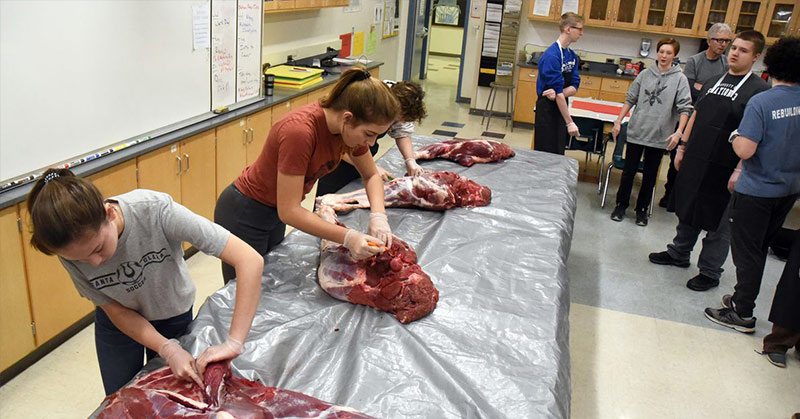At one time in history, hunting and trapping were a significant part of the fabric of North American culture. Over the last century, however, individuals and groups have become increasingly opposed to the activities, and farming and conventionally-raised animals have replaced wild game as a food source. One Alaska teacher hunted a moose in order to preserve that old tradition.
Since then, wildlife management administrators and policymakers have attempted to educate the public on the value of hunting and trapping, in order to counteract the argument to have the practice restricted or abandoned altogether [1].
In Alaska, however, the practice of hunting still holds significant cultural meaning, and a high school teacher there has created a special class to teach students the skill and value behind the traditional activity.
The World Discovery Seminar
Using a moose carcass that he hunted and killed himself, Brian Mason is teaching his students lessons in lessons in anatomy, life skills, and local cultural traditions. The alternative course, called the “World Discovery Seminar”, is taught at Chugiak High School. In the class, students were given four-inch boning knives and learned how to debone, trim, and process the meat properly.
The students also learned the anatomy of a moose as well as traditional ways the local indigenous people used hunting and trapping to survive.
“What I try to emphasize — and the World Discovery Seminar program as a whole — is to emphasize experiential learning,” explained Mason. “You can learn certainly about anatomy from diagrams and textbooks and videos but getting your hands on an animal is a big part of the science aspect of it.” [2]
Alaska Teacher Hunted A Moose – Preservation Of Tradition
Subsistence hunting, which is hunting for the purpose of food, occurs all year long in Alaska and is an integral part of the local culture. For the state’s rural residents, the practice is crucial to their nutrition, food security, and economic stability [3].
In 2011, a study conducted by the Division of Wildlife Conservation estimated that spending on hunting and wildlife viewing generated 4.1 billion dollars of economic activity in Alaska, created more than 27 thousand jobs, and produced 1.4 billion dollars in labor income [4].
The report also assessed the importance of wildlife to the residents themselves and found that 65 percent of Alaskan residents rated wildlife as an “extremely important” or “very important” contribution to their quality of life. This holds true even for those who do not actually hunt themselves [4,5].
Paideia Methodology
The course at Chugiak High School uses the Paideia Methodology to teach students. This type of learning emphasizes critical thinking, communication skills, and active learning, with a moral mission to empower the mind, body, and spirit through education. It focuses on the development of intellectual skills through reading, writing, speaking, listening, calculating, problem-solving, observing, measuring, estimating and exercising critical judgement. [6,7].
According to the program website, “The goal of WDS is to assist young people to become avid, self-motivated learners. In the classroom, students will examine, define, draw conclusions, articulate, and debate about the significance of great historical, literary, mathematical, and scientific ideas.”[8]
The Permit to Hunt
In order to offer the lesson to his students, Mason acquired an Education Harvest Permit, which allows game animals to be harvested for the purpose of education. The conditions are very strict, and only thirty to forty of them are given out every year [2,8].
The specifications for the permit are very specific: the moose had to be antlerless, and couldn’t be a calf or a cow with a calf. After the moose was killed, Mason had to submit a report detailing the age, sex, specific harvest location, and who shot the animal. He will also be required to submit a second report thirty days later that details the educational activities that took place [2].
Connecting Students with Local Culture
According to Tim Spivey, who works with the Alaska Department of Fish and Game, the program is a way of allowing educators and elders to pass on cultural traditions and practices related to hunting and gathering in the state [2].
The students processed around two hundred pounds of moose meat. Some of the meat will be cooked and eaten at a special dinner, but the rest will be donated to charity.
Mason is very encouraged by the success of the project, as it gave students a very well-rounded educational experience.
“I think that certain experiences you can’t really learn from a textbook,” he said [2].
As more and more local traditions and customs are at risk of being lost through modernization and globalization, programs like the WDS are connecting young people with their culture, while providing them with valuable knowledge and skills along the way.
Keep Reading: 10 National Parks Everyone Should Visit At Least Once
Sources
- E Commons.
- ” Subsistence Hunting in Alaska.” ADFG
- “The Economic Importance of Alaska’s Wildlife Wildlife Generates Billions for Alaska.” ADFG. Riley Woodford
- “The Economic Importance of Wildlife in Alaska in 2011.” ADFG.
- Paideia
- ” Welcome to World Discovery Seminar.” ASDK12
- “Mammal, Bird & Reptile Permits.” ADFG

